The SSD Improv: Intel & Indilinx get TRIM, Kingston Brings Intel Down to $115
by Anand Lal Shimpi on November 17, 2009 7:00 PM EST- Posted in
- Storage
Overall System Performance using PCMark Vantage
Next up is PCMark Vantage, another system-wide performance suite. For those of you who aren’t familiar with PCMark Vantage, it ends up being the most real-world-like hard drive test I can come up with. It runs things like application launches, file searches, web browsing, contacts searching, video playback, photo editing and other completely mundane but real-world tasks. I’ve described the benchmark in great detail before but if you’d like to read up on what it does in particular, take a look at Futuremark’s whitepaper on the benchmark; it’s not perfect, but it’s good enough to be a member of a comprehensive storage benchmark suite. Any performance impacts here would most likely be reflected in the real world.
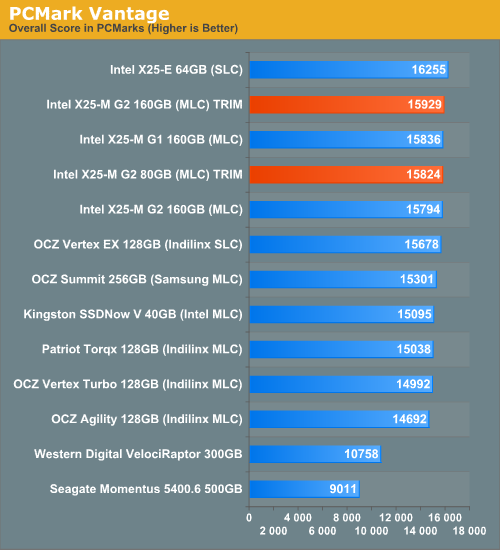
The overall impact of the TRIM firmware is negligable, no real improvements here - something you'll see echoed in nearly all of the PCMark results. The 40GB Kingston drive does well for its price, delivering performance similar to an Indilinx drive as it is crippled by a small amount of free space.
The memories suite includes a test involving importing pictures into Windows Photo Gallery and editing them, a fairly benign task that easily falls into the category of being very influenced by disk performance.

The TV and Movies tests focus on on video transcoding which is mostly CPU bound, but one of the tests involves Windows Media Center which tends to be disk bound.
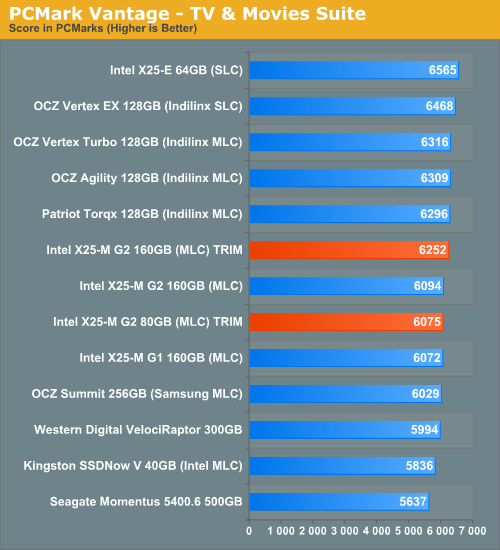
The gaming tests are very well suited to SSDs since they spend a good portion of their time focusing on reading textures and loading level data. All of the SSDs dominate here, but as you'll see later on in my gaming tests the benefits of an SSD really vary depending on the game. Take these results as a best case scenario of what can happen, not the norm.
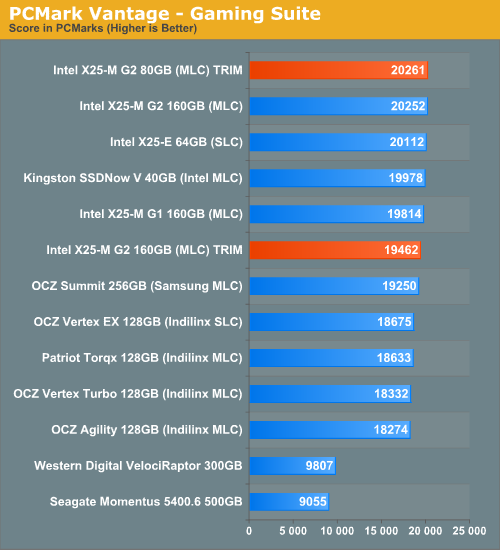
In the Music suite the main test is a multitasking scenario: the test simulates surfing the web in IE7, transcoding an audio file and adding music to Windows Media Player (the most disk intensive portion of the test).
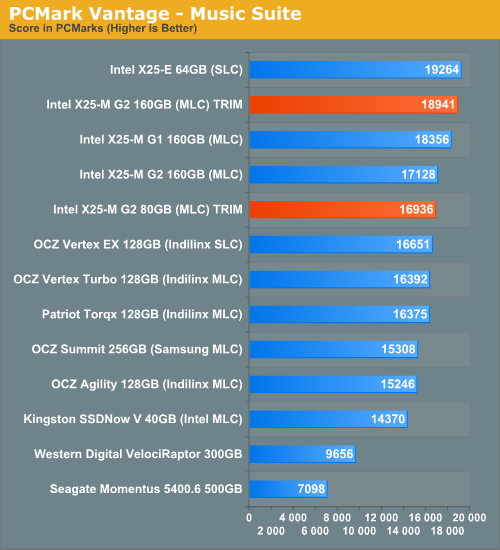
The Communications suite is made up of two tests, both involving light multitasking. The first test simulates data encryption/decryption while running message rules in Windows Mail. The second test simulates web surfing (including opening/closing tabs) in IE7, data decryption and running Windows Defender.
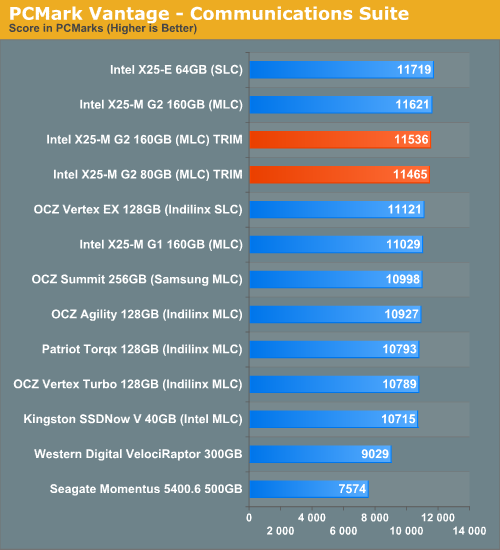
I love PCMark's Productivity test; in this test there are four tasks going on at once, searching through Windows contacts, searching through Windows Mail, browsing multiple webpages in IE7 and loading applications. This is as real world of a scenario as you get and it happens to be representative of one of the most frustrating HDD usage models - trying to do multiple things at once. There's nothing more annoying than trying to launch a simple application while you're doing other things in the background and have the load take forever.
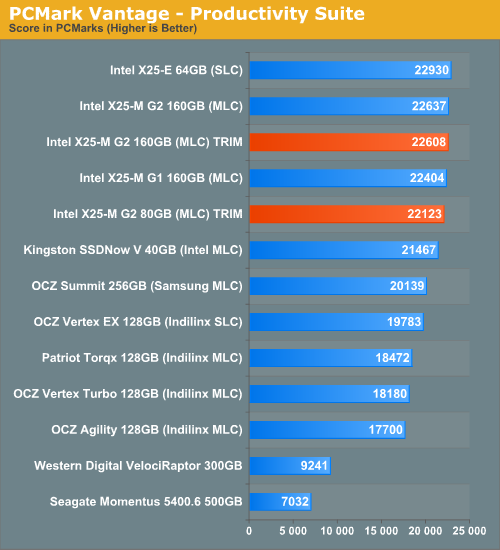
The final PCMark Vantage suite is HDD specific and this is where you'll see the biggest differences between the drives:
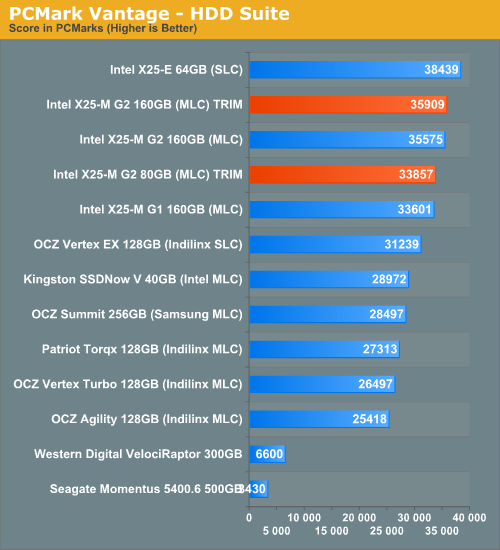










162 Comments
View All Comments
mrt2 - Monday, November 23, 2009 - link
Ok so with all this new data in mind, what's currently the fastest, least performance degrading 256GB SSD you can get for under $1000? I'm currently running Snow Leopard on a dual quad core Mac Pro... I'm not sure Snow Leopard supports any of the new technologies like TRIM or not... but whatever the best 256GB SSD I can get, that's what I'd like....rdhir - Wednesday, November 18, 2009 - link
WARNING on Intel Matrix driversI just wanted to add a word of warning over drivers and SSD. I just built a new i5 750/P55 system with a Corsair X64 drive (Indilinx). While the system worked fine in bits it frequently froze. I tried lots of things to cure it, but in the end the fix was simple. I HAD to use the Intel drivers to avoid intermittent freezing.
Because I had made the SSD the C:drive and used a 1TB Samsung F2 as the D: drive, I had not wanted to lose TRIM support, until the new AHCI drivers came out, but MS drivers don't work. reference article is here http://derek858.blogspot.com/2009/01/windows-7-int...">http://derek858.blogspot.com/2009/01/windows-7-int...
Reading around some of the othere references Its inconsistent and depends on how the drives implements the command set so your mileage may vary but I think its a big issue.
I think we could all do with an article on how best to configure an SSD based system. I decided that I wanted to move "Users" and all associated hidden directories to the D: drive (a 1TB HD) leaving the 64GB for Windows and Apps. This would mean it would never get too full.
I'm amazed at how difficult Microsoft make it to shift the "Users" directory to another drive. In fact they have a Knowledge base article saying not to - Linux easy, just map /home elsewhere.
In the end I followed some instructions to create a junction from C:\Users to D:\Users, but its non-trivial and involves opening a command window in the middle of the installation process.
Yes I'd like to have done it with an autounattend.txt but the MS KB articles says it won't really work.
mapesdhs - Thursday, November 19, 2009 - link
> In the end I followed some instructions to create a junction from
> C:\Users to D:\Users, but its non-trivial and involves opening a
> command window in the middle of the installation process.
I can't see this sort of thing becoming any easier until MS ditches
the archaic idea of drive letters and switches to a more natural
unified file system such as is used with all UNIX OS variants.
(oh look, the pits of hell seem to be getting a tad icey...)
Ian.
MadAd - Thursday, November 19, 2009 - link
"I think we could all do with an article on how best to configure an SSD based system"That would be great
CuriousMike - Monday, November 23, 2009 - link
" "I think we could all do with an article on how best to configure an SSD based system""That would be great " "
Thirded.
The variety of do's and don'ts (and conflictions) are numerous:
-do disable pagefile. don't. oh, which OS?
-don't defrag disk. do. oh, which OS?
-use ram disk for temp files. don't. no, wait, do.
ol1bit - Wednesday, November 18, 2009 - link
I can't believe they don't have firmware for my drive to trim it... I just bought the sucker 3 months ago.....Intel X25-M SSDSA2MH080G1 80GB SATA II MLC Internal Solid state disk (SSD)
dagamer34 - Wednesday, November 18, 2009 - link
No TRIM for G1 drives. Sorry.yacoub - Tuesday, November 17, 2009 - link
An old article reposted as new simply because of a couple-sentence-long update? Interesting.Also, $85? No, try $130 and no MIR. Thanks ScrewEgg!
http://www.newegg.com/Product/Product.aspx?Item=N8...">http://www.newegg.com/Product/Product.a...pk=kings...
7Enigma - Tuesday, November 17, 2009 - link
If the only update was the 2 short blurbs at the top of the first page I don't think this entire article should be reposted. A simple statement with a link to the previous article would be fine. I just wasted a couple minutes going through each page realizing nothing was new....not cool. I was psyched for another SSD article Anand!max22 - Tuesday, November 17, 2009 - link
I installed Intel's pulled firmware fine on my G2 drives. Nothing happen to them at all. I think the whole issue has been blown way over the top.